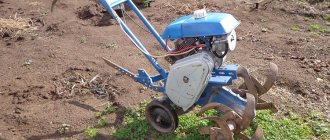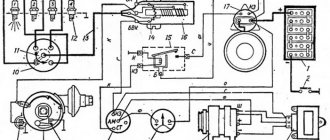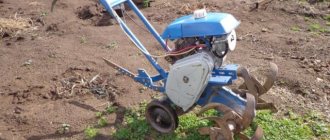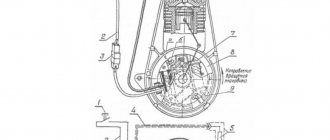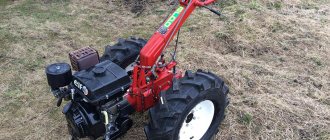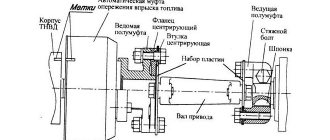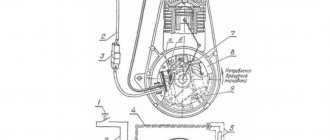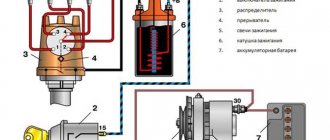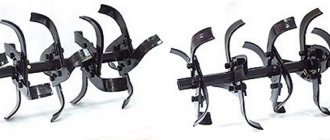These walk-behind tractors were born back in the 80s and are rightfully considered the starting point in the production of agricultural mini-equipment. The main task of the Mole cultivator, like a number of mini tractors from other manufacturers, is to cultivate a plot of land. Usually these are homestead areas, vegetable gardens and summer cottages. To dig up such areas with a shovel, you need to spend a lot of time and precious health. It is walk-behind tractors that come to the aid of people.
Motoblocks have gained popularity since the 80s
Description
The “Mole” motor-cultivator appeared in the early 80s of the last century and immediately gained popularity among rural residents and dacha owners. This is not surprising, because with the help of this agricultural technology, mechanized soil cultivation, as well as planting, care and harvesting, became possible.
Over more than 30 years of its existence, “Mole” has been modified more than once. Such parts as the engine, gearbox, handles, cutters, as well as other equipment (including attachments) were brought to perfection. Having gone through a difficult path of improvements, we no longer received the original motor cultivator, which has some limitations in operation, but a multifunctional motorized device, with which we can easily carry out the following field work:
- plowing the soil;
- cutting beds;
- planting potatoes;
- spud of plants;
- weeding plants from weeds;
- mechanized potato harvesting;
- mowing;
- irrigation;
- transportation of bulk and piece goods;
- snow removal.
In order to perform all of the above work, you need to acquire the appropriate tools. You can find out more in the article about attachments for the Mole cultivator on our website.
No matter how powerful your unit is, no matter how much you care for it, sometimes it still requires repair - the engine won’t start, the engine gets hot, or some other malfunction... To know how to repair a motor cultivator, you need to understand its structure.
Spare parts for Mole walk-behind tractor and specifics of work
The motor cultivator comes with 4 cutters (the cultivator will move during soil cultivation due to them): two outer ones are attached to the left gearbox shaft, and two inner ones are attached to the right one.
The motor cultivator can also be used with six cutters, which will significantly increase its productivity. But it is not recommended to use a larger number of cutters to avoid damage caused by excessive loads on the engine and frame.
The depth of soil milling is adjusted by installing a coulter. During operation, the operator, by changing the load on the coulter, can adjust the depth of processing, as well as prevent the cultivator from burying in one place, because the engine has a Mole piston , the walls of which are tinned and therefore tightly ground into the cylinder.
Variations of working with the Mole walk-behind tractor
Another of the main functions of the Mole is weeding, for which ordinary knives are replaced with L-shaped ones. To plow the soil, plant and dig potatoes, rubber-coated wheels are attached to the gear shafts instead of cutters, and a plow is installed in place of the coulter, three varieties of which are included in the kit: regular, for hilling and for digging potatoes.
To make it easier to mow the area, and indeed any desired area, the included serial factory mower will help, the torque to which is transmitted from the engine auxiliary pulley using a timing transmission.
It is worth noting that the types of equipment listed above allow you to capture a strip of soil with a width of 350 to 600 mm during processing. For the transportation of small loads, the manufacturer provides a TM-200 trolley, the load capacity of which is 200 kg.
Another important feature of the Krot motor-cultivator is the ability to attach the MNU-2 pumping unit to the front brackets, which will make it easier to water the beds and help roll water out of the cellar during the spring melting of snow.
To operate the pump, you will have to disconnect the belt from the gearbox and attach it to the installation, after which you will have to move the Mole using your own force.
During its existence for decades, the Mole motor cultivator has established itself as a reliable and indispensable assistant in the garden.
And if you need to repair the engine, then it is better to purchase a piston for Krot in a company store or order it from us in the online store.
Common breakdowns
What machine elements may require the operator's close attention?
Let's list them:
- motor;
- magneto, ignition system;
- carburetor;
- gearbox;
- air filter, etc.
Now let’s take a closer look at all those malfunctions that can affect the performance of the unit, no matter what model it belongs to.
Does not start
So, what to do if the “Mole” does not start, what could be the reasons for this? The ignition fails or there is no ignition at all in the following cases:
- No spark. This could mean the spark plug is burnt out. In this case, you need to unscrew it and simply replace it with a new working one.
- The spark plug is smoked. A good cleaning will bring it back to life (remove carbon deposits, clean the contact), after which the spark plug must be thoroughly rinsed in gasoline.
- If the cultivator does not start, but there is a spark, then most likely the reason is a lack of insulation. We look at the candle again, in this case it is wet or slightly damp. You don't have to change the entire spark plug; you only need to replace the tip.
- Poor quality fuel may cause the cultivator to fail to ignite. It is for this reason that the spark gets wet, after which you will have to change the tip.
- Fuel dripping from the spark plug is another reason why the car will not start. To rectify the situation, it is necessary to drain the cylinder by bleeding the engine using a manual starter.
- The reason for the lack of ignition may also be problems with the fuel supply hoses. To restore the operation of the cultivator, it is necessary either to properly tighten the hoses, or, in case of rupture, replace them with new ones.
- Poor insulation of the electrical system (high and low voltage wires) can also cause the unit to not start.
- Pay attention to the air filter. If it is dirty, then problems with ignition are guaranteed. It needs to be either cleaned or replaced. Most often they resort to the second option, fortunately, this spare part is available both in price and in availability in the store.
- Failure of the magneto itself. This part cannot be repaired and is immediately replaced with a new one. How to check the magneto of the “Mole” motor-cultivator to make sure it is faulty? Yes, it’s very simple - if all the reasons why there may be no spark are excluded, then the cause of the malfunction is in the magneto. Many craftsmen rework the working magneto, thereby increasing its service life.
This is what the Magneto ignition circuit for the “Mole” motor cultivator might look like
- There may be no ignition if the flywheel plates jam the magneto cores.
- An incorrectly set gap between the electrodes will not allow a spark to escape.
Video review of the modernization of the ignition of the “Mole” motor cultivator
As you have seen, setting the ignition is not so difficult.
Engine
The main reasons that the “Mole” engine does not start are:
- lack of fuel (or its low quality);
- ignition problems discussed above;
- the appearance of decompression and, as a result, piston wear and deformation of the exhaust valve.
In the first case, it is enough to simply fill in the required amount of fuel (a mixture of gasoline with M-8V autolom oil) and all problems will be resolved. In the case of a compression failure, you will have to completely disassemble the engine and replace damaged parts, and this could be a piston or an o-ring.
Deformation of the exhaust valve becomes another cause of compression failure, which leads first to a loss of power of the “Mole” motor-cultivator, and then to starting problems.
To restore engine functionality, it is necessary to completely disassemble it. Having assessed the condition of the piston, replace it if necessary. We change the piston rings and exhaust valve. We examine the engine head, in particular the gas distribution mechanism, and if there is carbon deposits, we clean it. If structural elements are damaged, we replace them with serviceable ones.
Motor selection
During the Soviet Union, only domestically produced two-stroke single-piston engines were used, which were not particularly powerful. Today you can find “Mole” with a four-stroke imported engine. But if you still have the first model of a cultivator in your arsenal, then upgrading your “Mole” by replacing the motor is not at all difficult.
And here a new question arises: which engine is better to install on the unit? It’s not difficult to answer - those models that are installed in newer cars are suitable.
It is best to replace the domestic engine with an imported one:
Any of them will not only give the motor-cultivator a new life, but will also significantly increase the power and service life of the unit.
An excellent solution would be to install the Lifan engine on the “Mole” motor-cultivator. Such a motor provides the car with a long life, because in addition to reliability and efficiency, Lifans also stand out for their unpretentiousness and definitely do not require additional attention.
Video review of replacing the engine on a Lifan 168 F-2 with a Mole cultivator
Carburetor
What is a carburetor and why do you need to adjust it? A carburetor is a small device designed to produce a fuel-air mixture. This mixture, with the help of a piston and a spark plug, will be maximally compressed and ignited, and the engine will start and continue to operate.
Carburetor adjustment must be carried out after the first working season.
Carburetor adjustment is one of the mandatory points included in the “maintenance” section of the unit. Thanks to timely inspection and repair, the service life of the cultivator will increase. In addition, inspection and adjustment are also necessary when the engine roars strongly for no apparent reason.
Before we start setting up, we need to familiarize ourselves with the design of the carburetor of the “Mole” cultivator:
So, to debug the fuel supply and ensure the required speed, you need to turn to two screws: the number of revolutions (in Fig.) and the quality of the fuel (Fig. ). Using these two screws, we adjust the fuel supply to the carburetor of the “Mole” motor-cultivator at idle speed. You must act very carefully; first check the state of the ignition.
Important! Thoroughly clean the carburetor, where necessary - strip it, wash it, where necessary - change parts. Then the Mole motor cultivator will serve you for a very long time.
Owners of the unit are often interested in how to start the “Mole” cultivator after winter. The reason for the lack of ignition is condensation in the carburetor that has accumulated during inactivity at changing temperatures. Complete disassembly of the device and further cleaning will help solve this problem. All kinds of additives found in low-quality fuel and dust that has seeped through the filter will also not contribute to the operation of the device.
Gearbox
The main task of the gearbox is to transmit torque from the engine to the shaft. The transmission of motion is carried out using a V-belt transmission. You can learn more about the design and repair of the gearbox of the “Mole” motor-cultivator by watching the video.
Video review of the Mole motor-cultivator gearbox
Reverse
The first modifications of the “Mole” are not equipped with a reverse function (reverse speed), which somewhat affected their performance characteristics and ease of working with such attachments as a cart, snow blower, mower, etc. To modify the “Mole”, the manufacturer released new modifications of it , already with a reverse function, which significantly increased the mobility of the cultivator.
Video review of the reverse function on the Mole motor-cultivator
Drive belt
The drive belt transmits torque from the engine to the gearbox. The cause of breakdown of the “Mole” motor-cultivator is often a rupture of the drive belt. This occurs due to the belt jamming during operation due to heavy loads on the working parts of the cultivator (hard soils, blunt cutters). The cutter bends and catches the belt with the knife, thereby rendering it unusable.
Drive belts for the “Mole” cultivator can have various modifications, but their dimensions are strictly defined:
DIY gearbox repair
Owners of a Mole motor-cultivator whose gearbox has failed have two options:
- Take it to specialists who will repair damaged gearbox parts quickly and efficiently.
- Troubleshoot the problem yourself.
The first method is a priority, since there will be an almost 100% guarantee of quality and safety. The second method is risky, and people who are not confident in their own abilities should not take it on. The gearbox troubleshooting process is as follows:
- Make sure that the oil in the system is at the proper level and is not leaking. If not, add the required volume and fix the leak.
- Check the condition of the fasteners of the main components. If loose elements are found, tighten them.
- Remove the reduction gear and check the condition of its parts and bearings.
- Remove the oil seal and gear from the gearbox.
- Rotate the crankshaft and check how the oil seal moves. Perhaps it is not seated tightly and is leaking oil because of this.
It is advisable to perform the remaining actions under the supervision of a technician who thoroughly understands the mechanism and can see other causes of the malfunction. As a tip, experienced owners recommend not changing gears while driving. Do this only after the walk-behind tractor has completely stopped.
Maintenance
What does maintenance mean? This is a series of measures that ensure proper operation and proper storage of equipment. Maintenance of the “Mole” cultivator means the following work:
- washing;
- cleaning;
- lubricant;
- control;
- gas station;
- control;
- fasteners;
- adjustment of all blocks and systems
Such work must be done as often as possible, especially if you have to work in unfavorable conditions.
Before starting the cultivator engine, it is necessary to check the presence of fuel, oil, etc. It is necessary to fill the mixture to a certain level, and if necessary, replace the fuel and oil. For cultivators, Avtol oil (M-8V) is used, which proved itself during the Soviet Union.
If it is difficult to get it, then you can use analogues:
- 10W-30 (do not use at temperatures above +27 degrees);
- SAE 30 (do not use at temperatures below +4 degrees).
Adjustment work involves adjusting the clutch, reverse gear, carburetor, spark, etc.
Cleaning work includes cleaning the filter, working surfaces, housing and all clogged parts on the surface of the Mole motor-cultivator. If malfunctions occur, or for preventive purposes (less often), it is necessary to clean the internal parts of the machine.
Before putting any part back in its original place, make sure it is in good working order.
Installation or replacement of any attachments must be carried out with the engine completely turned off. When preparing for long-term storage, the motor cultivator requires conservation. To do this, you need to prepare the engine in a certain way (see instructions), then clean (rinse) and dry all the external parts of the “Mole”, wipe them with a rag, drying them well. After this, you need to lubricate all accessible areas of the cultivator with grease. The unit is now ready for a long rest.
What to do if the problem is in the engine?
Most often, owners of cars of this brand are faced with engine problems, for example, it does not start or its performance is unsatisfactory. Among the signs of a breakdown: spontaneous stopping, power does not gain, interruptions are heard.
Here is a small instruction on how to determine the breakdown:
- Check the ignition;
- Make sure there is fuel in the gas tank;
- If you doubt the flow of fuel to the carburetor, check the fuel filter;
- Clean it if necessary;
- Start the cold engine;
- The carburetor choke must be closed.
If you cannot find the cause of the malfunction of the Mole motor cultivator and fix it yourself, contact a specialist
see also
Comments 21
It’s normal for there to be so much dirt on the cylinder, how did you keep it cool? In general, the engine is not very good, weak and noisy, you need to install a Chinese one on it, but that will be a different matter)
We are made in the USSR. I borrowed a Chinese one from a neighbor as a replacement, I thought I wouldn’t be able to finish it - the cutters are small, everything bends and sag, I ate gasoline like an adult... We can’t beat the Chinese, we can’t)
I meant the Lifan 6 hp engine. It rushes at idle very confidently, judging by the reviews. And of course their cultivators themselves are so-so. I also have a mole with the original engine, only the piston on it died, it needs to be changed.
I thought that I wouldn’t find a magneto, so many years have passed and there are plenty of them... Most likely there is a piston one too and it costs a penny.
What oil do you use to dilute gasoline?
While there was an M8, I diluted it with it, now for two-stroke engines - STIHL, I read that it was not very good, but there is no other way.
They gave me something in the store for 2-stroke engines - the engine doesn’t want to work for a long time! I used to pour anything - autol - diesel and it worked! Now the seals need to be changed!
I read about oil seals. If it’s necessary, then it’s necessary. What you like is that everything can be taken apart on your knee.))
Maybe it will be useful to someone. Although, it’s unlikely. Such equipment can’t be found now, only China is around)
Whoever needs it will take a look)))
That's for sure. I still have a boat motor left over from the old days - “Salute”. He also lost the spark about 10 years ago. Now I looked at the documentation, and there is the same magneto)) The capacitor, by the way, is working, the winding of the high-voltage coil turned out to be short-circuited. This is so true)
Here's how to even)) Resolder the capacitor and the boat motor can also work)))
The condenser is working, the coil has broken.) I don’t know what the boat has yet.
Let's hope then that one of the two will work out)
Must! If it does not work out. I’ll install a new one, the path is already trodden))
Chainsaw magneto friendship?
Magneto from "Mole". But, most likely, it went and goes into many two-stroke engines.
Visually, the Ural chainsaw magneto is very similar. If possible, write down the markings, and I’ll compare them with my chainsaw magneto, maybe they’re identical.
How to install a new engine on the Krot cultivator
I don’t know about you, but I already miss summer and spring. When it’s wet, cold, dark and dirty, you really want heat, sun and light. I have already mentioned that I have a very good attitude towards agriculture, I love it to some extent and do not mind working with my hands. This feeling is indescribable and certainly joyful and positive even when the sweat is pouring into three streams. Today we will try to figure out how to install a new engine on the Krot cultivator.
In the picture above, one of my favorites is the Mole motor-cultivator with a Chinese engine, which over the years has survived the transplantation of a capricious dying domestic 2-stroke and regular maintenance work. Of course, a small, weak motor-cultivator is not capable of cultivating a large field and cannot compete with walk-behind tractors and mini-tractors, but it is a pleasure to cultivate several hundred acres on it. Next I will tell you how I installed a new engine on the Mole cultivator.
Mole cultivator - engine selection
The gearbox, which is already 20 years old, and the new NOMAD NT200 engine (analogue of the Japanese HONDA GX-200 engine) work very well and are a great help in the household.
Now there are a lot of wonderful equipment from different manufacturers, but if the price bothers you, try looking for an old Mole, put a new engine on it and it will serve you for a very long time, fortunately, the modification consists, by and large, in 2 holes in the frame for mounting the engine, buying a new pulley and... nothing else.
The engines have hardly risen in price and cost about 6000-7000 rubles (for a 4.5-5.5-6.5 HP engine made in China such as Champion G200HK, NOMAD NT200, Lifan), a pulley is a maximum of about 500, I talked about belts, and hands , if out of the question, they will help you save a couple of thousand on remodeling work. I assure you that the alteration only involves 2 new holes, no matter how the service center tries to tell you.
We install the engine on the cultivator
First, as I said, you need to make a couple of new holes, increasing the engine stroke. This is necessary so that you can tighten the belt by moving the engine a little forward.
So, we drill holes and file them so that the fastening bolt can move freely.
You bought a pulley with a key with the engine, there is a belt. We fasten the engine with 4 bolts. Don't forget to install a washer-grower, otherwise the vibration will cause the nuts to unscrew. We tighten the belt. The belt for "Mole" is brand A-750 .
Why the walk-behind tractor won't start, there is no ignition and the spark is gone, how to start a walk-behind cultivator - reasons
If you are looking for the optimal price-quality ratio, we recommend that you pay attention to the domestic Mole walk-behind tractor, which has been produced since 1983. The walk-behind tractor is still produced today in the Moscow and Omsk machine-building plants. In recent years, high-quality technical characteristics have allowed it to successfully compete with many foreign units. But there are also times when you don’t know why the Mole walk-behind tractor doesn’t start, or it doesn’t start well, or there’s no spark in it. Maybe the starter needs repair, or maybe the ignition is not working properly. In general, this issue and the reasons should be carefully examined.
Prevention and operating rules
To prevent malfunctions of the Mole motor-cultivator, you need to know the basic rules for its storage and operation. They depend on how long the equipment will be inactive. If you will not use it for a long time, here are a few rules:
- You need to start the engine so many times that the carburetor remains empty
. - Machine parts that move and rotate must be carefully lubricated with high-quality oil
. - Daily maintenance
is required. - The surfaces of the walk-behind tractor are wiped daily with a rag
soaked in the fuel mixture. - If any parts fail, install new spare parts
.
If you want to operate the Mole walk-behind tractor for a long time, without repairs, be sure to undergo maintenance. Do not buy cheap, “left-handed” spare parts. Only original spare parts will ensure high-quality operation of your equipment after repair. Regular inspection and maintenance guarantee a long service life.
The device of the Mole walk-behind tractor
Motoblocks, which were characterized by simplicity of design, began to be produced more than forty years ago. The first models were equipped with an insufficiently powerful engine and could only be used in a narrow range of jobs.
The first buyers of Mole were not very happy with the insufficient power of the power unit; as a result of numerous complaints, they began to improve the walk-behind tractor. Today, the Mole model is the most successful and versatile model of domestic cultivators among all those on the market.
Small in size, it can be used for various purposes: weeding, loosening, harrowing, leveling. The walk-behind tractor can be used even on a small plot of land, the area of which does not exceed 10 acres.
Walk-behind tractors Krot, Carver, Champion, Plowman, Profi, Huter, Don, Sadko can be used with a diverse line of additional attachments.
As standard, you will be provided with a coulter and a cutter for the Mole. Additionally, you can buy a plow to plow the land and a potato digger.
What are the main advantages of this unit?
- simple design,
- high efficiency,
- affordable price. This contributed to the fact that the model became incredibly popular among domestic buyers.
- There is nothing superfluous in Mole, thanks to which he regularly copes with all the tasks assigned to him.
For more information about the operation of the Mole walk-behind tractor, watch the video:
Deutz-Fahr tractors
The German brand Deutz-Fahr specializes in the production of agricultural machinery and tractors. The golden rule of a manufacturer is to invest in development and innovation. As a result, modern and reliable agricultural equipment comes off the assembly line, which makes work easier and increases productivity significantly. Today, about 1 million tractors of the brand are in use around the world.
Products
The brand produces a large number of agricultural equipment, the most popular being tractors, precision farming systems and combines.
Today the following series of tractors are produced:
- 6G.
- Episode 9 TTV.
- Episode 6.
- Episode 7 . . . .
- Agrotrac 130/150/170. .
- Agrofarm G410/430. . .
- Agroclimber F.
- Agroplus FVS.
Precision farming systems are used in many modern agricultural enterprises. Automated control and synchronization of operations significantly increases work efficiency. Deutz-Fahr offers reliable and highly precise automation. The precision farming system from Deutz-Fahr is:
- Reception of signals using all satellite systems, including corrective ones.
- A single interface for all processes and applications. Its diagonal can be 8 or 12 inches.
- Steering systems are represented by visual, power steering.
- High-precision sectional control that eliminates overlaps and skips.
- Possibility of complete automation of data management.
- A security system for large tractors has been introduced; the cameras have a wide viewing angle.
- .
- HTS 6060/6090/6095. .
History and demand
The history of the brand began much earlier than 1977, which appears in many sources. The main character was Nikolaus August Otto, who founded the world's first company specializing in the production of engines in 1864. Already in 1890, a thresher was invented. 4 years later, the first Deutz tractor with a 26 hp gasoline engine was released. In 1927, the first diesel tractor Deutz MTN222 was produced, which in fact became the beginning of mass production of standard and now familiar tractors.
How to set the ignition
You can set the ignition using these methods.
Use a strobe
- It is worth warming up the engine to a temperature that is optimal for operation.
- Connect the power supply of the strobe to the walk-behind tractor network.
- The sensor that is responsible for the triggered sound must be placed on the high-voltage electrical wire of one of the cylinders.
- Remove the vacuum correction hose and plug it.
- The strobe light must be pointed at the pulley.
- Start the engine, the speed should be idle.
- Rotate the distributor housing.
- Create a fixation during which the pulley mark will reach the required mark on the cover of the device.
- Secure the fastening nut.
Using the lamp
- It is necessary to turn the crankshaft to a position during which the pulley mark will reach the required mark on the gas distribution mechanism, while the slider responsible for interrupting and distributing the ignition should point to the high-voltage wire of one of the cylinders.
- Reduce the force that secures the distributor housing nut.
- Connect one of the wires of the control lamp to a metal wire that serves to transmit electric current that goes from the switch-distributor to the ignition coil, and the next wire to the “ground” of the walk-behind tractor.
- Be sure to turn on the ignition.
- Rotate the body of the mechanism that determines the moment of formation of high-voltage pulses in the ignition system in the clockwise direction until the lamp stops burning.
- Slowly turn the breaker-distributor in the other direction.
- Create a fixation for the breaker-distributor, and the control lamp should light up.
- Tighten the nut that secures the distributor.
With a spark
- The crankshaft should be turned to a position during which the pulley mark will be identical to the same mark located at the base of the gas distribution mechanism, and the interruption-distribution slider will point to the high-voltage wire of one of the cylinders.
- Reduce the locking force of the nut, which preserves the body of the mechanism that determines the moment of formation of high-voltage pulses in the ignition system.
- From the cover of the mechanism that determines the moment of formation of high-voltage pulses in the ignition system, it is worth removing the high-voltage wire, which is located in the center, and its contact must be placed at a distance of 0.5 cm from the “ground” of the walk-behind tractor.
- Don't forget to turn on the ignition.
- The body of the mechanism that determines the moment of formation of high-voltage pulses in the ignition system should be turned 200 clockwise.
- Slowly turn the mechanism, which determines the moment of formation of high-voltage pulses in the ignition system in the other direction.
- The position of the mechanism, which determines the moment of formation of high-voltage pulses in the ignition system, should not move. In this case, a spark will occur between the contact of the wire that is located in it.
- It is worth tightening the breaker nut.
You can hear him
- Turn on the motor.
- Loosen the nut that secures the distributor base.
- Slowly rotate the interrupter housing on both sides.
- The position of the mechanism, which determines the moment of formation of high-voltage pulses in the ignition system, must be fixed in the position when the engine power is most stable and the speed reaches the maximum level.
- The breaker body must be turned clockwise.
- Secure the distributor fastening element.
Video instructions
If you don’t have a Mole cultivator yet, but are thinking about buying one, be sure to watch this useful video about all the advantages of this machine:
These walk-behind tractors were born back in the 80s and are rightfully considered the starting point in the production of agricultural mini-equipment. The main task of the Mole cultivator, like a number of mini tractors from other manufacturers, is to cultivate a plot of land. Usually these are homestead areas, vegetable gardens and summer cottages. To dig up such areas with a shovel, you need to spend a lot of time and precious health. It is walk-behind tractors that come to the aid of people.
Motoblocks have gained popularity since the 80s
Malfunctions and causes
If the Mole, Forza, Viking, Crosser, Foreman, Texas, Patriot, Cayman walk-behind tractors do not start and stall or there is no spark in the ignition system, this means that you did not carefully monitor the engine ignition system. You should conduct weekly:
- Control.
- Visual inspection.
- Measuring the distance between the spark plug electrodes and checking the set stage of magneto sparking. For these manipulations, a probe is required.
Ignition malfunction is the most common breakdown that occurs in the Mole walk-behind tractor.
What should you do if your walk-behind tractor does not start and the ignition system of the Mole walk-behind tractor does not work:
- First you need to check the spark plug. Unscrew and inspect it. If you need a separate spark plug for a mole walk-behind tractor.
- Installation of the spark plug must be carried out by first installing the sealing ring, screw it in by hand until it stops, and then use a spark plug wrench. When tightening, do not apply excessive force - this may cause the cylinder head threads to break.
- If the spark plug is dry, it means no fuel can get into the cylinder.
- If fuel drips from the spark plug, it is necessary to “bleed” the engine using a manual starter, this way you will dry the cylinder.
- If there is a lot of carbon on the candles, it should be cleaned with small sandpaper and gasoline.
- Place a square of wire on the spark plug and firmly squeeze the base of the spark plug towards the cylinder, wrap it with electrodes in the direction opposite to the hole. It should be located under the candle at the base of the cylinder.
- Rotate the engine crankshaft several times. The starter cord will help you with this. If the ignition system is working correctly, you will see a sky-colored spark with a white tint between the spark plug electrodes. If it is missing or it varies in color, this indicates that the ignition system is not working properly.
If you did everything correctly, then now you undoubtedly know how to start a Mole walk-behind tractor.
What other reasons could there be for the breakdown?
No spark
If there is no spark during ignition, this indicates that the spark plug is malfunctioning and needs to be replaced urgently. Maybe the problem arose due to the absence of an electrical circuit in the contact or the gap between the magnetic wire and the ignition coil is broken.
Problem with spark plugs if the starter does not work
You can purchase spark plugs for the Mole walk-behind tractor in a specialized store or at the automobile market.
Gasoline hose
The ignition of the Mole directly depends on the proper operation of the gasoline hose, insulated high-voltage wires and their contacts. All these connections and parts will need to be thoroughly checked. The flywheel plates must not touch the magneto cores. Pay attention to hide touch marks.
If you were unable to find a fault in the ignition yourself, and the starter for the mole walk-behind tractor still does not work, we strongly recommend that you contact a specialist. You cannot solve a more serious problem on your own.
Features of self-repair of a cultivator
If you have figured out why your Mole cultivator won’t start, then it’s time to start repairs. Since most often the essence of the problem lies in the violation of the distance between the magnetic shoe and the stator, it is necessary to consider the features of repairing this breakdown.
The repair algorithm for the Mole motor cultivator is as follows:
- First, remove the fan housing;
- Do not completely loosen several mounting bolts;
- Install the feeler plate into the gap between the flywheel shoe and the stator, screw in the fasteners;
- Rotate the flywheel and observe the gap.
After completing these operations, you need to check for the presence of a spark at the body ground. To do this, use the starter to rotate the crankshaft. If there is no spark, then the starter will need to be replaced immediately.
1 Review
With proper and rational use of the Mole walk-behind tractor, it will serve you for many years. Remember that it is better to prevent ignition failure than to carry out repairs later.
Repair if the walk-behind tractor does not start or stalls
If your ignition does not work, the Mole walk-behind tractor does not start, and you want to repair the electronic ignition, check the stator and magnetic flywheel shoe.
Also check the distance between these elements, which should be from 0.10 to 0.20 mm.
The chainsaw is powered by an internal combustion engine. This is a simple device, the design of which does not have any special bells and whistles. Here you will learn how to start a chainsaw.
To prevent snow from becoming a serious problem for you, you should use snow removal equipment. Champion snow blowers provide excellent quality for many years.
Tractors were successfully used in agriculture on collective farm fields, in cowsheds, and for cleaning city streets by utility companies. Here is all the useful information about the Uralets mini tractor.
To set the gap between the stator and the magnetic type shoe:
- remove the fan housing;
- loosen (but not all the way to the base) a couple of fastening bolts;
- mount the probe plate into the distance between the stator and the flywheel shoe, tighten the bolts that are fixed so that the plate passes within this distance;
- turn the flywheel and pay attention to the gap that was built in around the entire perimeter.
After the gap has been set, it is worth paying attention to whether there is a spark on the “ground” of the housing:
- remove the spark plug square from the high-voltage cable and attach the freed edge at the base of the cylinder with a gap (0.3...0.5) cm between the head and the part of the cable that is not insulated;
- Using the starter, rotate the crankshaft, and a spark should appear, which ensures a breakdown of this gap.
If there is no spark, the starter should be replaced immediately. If a spark appears, it is necessary to check the contact of the high-voltage wire in the spark plug bracket or replace it.
The most common ignition defects:
- Breakdown of the end part of the starter spring at the point of contact with the drum.
- The starter cord is broken.
- Malfunction in the ratchet mechanism.
An unusable spring can be replaced or, if you have the necessary tools and knowledge, it can be easily restored.
To do this, it is worth annealing the end part of the spring at a distance of (10...12) cm on a simple burner using a file.
It is necessary to make the same profile for connecting the spring to the starter drum. Wind the spring onto the latter in the clockwise direction so that its unused edge is engaged and inserted into a specific mounting location on the fan housing.
Center the starter drum using the appropriate screwdriver. The claws (whiskers) of the restrictions must be adjusted to the fan housing, then cock the drum with the spring.
Fully release the spring that is charged several turns and connect the holes of the fan housing and the drum starter; all adjustments must be carried out extremely carefully.
Install the starter cord and make knots in the starter drum, then release it while maintaining tension in the cord handle. Replace the starter cord.
Please note that when purchasing a walk-behind tractor, you must carefully study the instructions for its use.
The ignition circuit of the Mole walk-behind tractor is also mandatory to study. The latter will provide you with the necessary knowledge on the design of the device, you will be able to quickly navigate during a breakdown.
General structure and characteristics
The mechanism is characterized by a simple structure and the presence of a small number of components and assemblies. It includes:
- Gasoline internal combustion engine.
- Support frame.
- Gearbox.
- Bracket for mounting additional equipment.
- Engine speed increase handle.
- Starter.
The cultivator has the following characteristics:
- Engine. Two-stroke, single-cylinder. Engine power - 2.6 horsepower. Engine capacity - 60 cc.
- Oil: to add to fuel - M 12 (the proportion of oil to gasoline should be 1k15); for the walk-behind tractor gearbox - MG 8A; for the output gearbox - TAD 17.
- Dimensions: length -1.3 meters; width - 1.06 meters; height - 0.81 meters.
- The fuel tank capacity is 1.8 liters.
- The ignition system is electronic.
Modernization of the ignition system (MB-1) of the Krot motor cultivator
Greetings to all! I would like to talk about the modification of the Mole ignition system, which allowed me to get rid of all problems with ignition reliability, and subsequently made it much easier to start the engine. I have never seen such a modification on the pages of this forum, or in other places either, and I hope that the work I have done will be useful to someone. First things first. I made the first alteration back in 2011. The message was simple. The main problem with the MB-1 magneto, in my humble opinion, is its miniature size (as well as one flaw in the circuit). If the designers had immediately followed the path known from light motorcycles - they would have separated the generator coils, the electronic circuit and the ignition coil into different units, then there would have been no problems with the ignition. And then it turned out that the generator coil is wound with a very thin wire, and the ignition coil is too small, and most importantly, the electronic circuit is installed directly on the engine crankcase and easily heats up to 70-80 degrees. But the KU202N thyristor used in the magneto is designed for a temperature of 75 degrees. As a result, it often fails. After all, the same thyristor was used in many motorcycles and mopeds and nothing worked. The thin wire of the generator coil winding did not make it possible to develop a large current and install a storage capacitor of at least 1 µF, and how to add a zener diode in motorcycles to cut off excess voltage. In general, the idea was born a long time ago to separate all three ignition elements. I immediately decided to use a car reel, which has multiple reserves. Then, with a large car coil, the spark with the same circuit turned out to be at least three times more powerful. And then a Toyota car coil with a switch turned up very successfully. The switch burned out and I just installed my own circuit in its place. Attaching photo. The coil was installed on a plate on the steering wheel. The high-voltage wire is standard, automotive. From the original MB-1 I left only the generator coil and the sensor coil. I wired them out, and decided to use a shielded one for the sensor. In principle, everything is clear from the photo, but if you have any questions, I’ll explain. I will give a description of the circuit and the circuit itself a little later. But that's not all, the whole tsimus is ahead.
So here it is. What happened after the first rework was enormous reliability. Military thyristor T122-25-8, 1000 volt diode bridge, monumental ignition coil. There are no more weak points. The previous owner replaced 6 MB-1 over 10 years of operation. And now it won’t break. But there was also a reason to be sad. The circuit that worked perfectly on the table, giving such a spark that it would stop an elephant, wilted somewhat on the engine. The spark power has dropped. After some time it became clear what was going on. The reason for this is the generator coil. Very thin wire and many turns. Only the DC resistance is about 3 kOhm. But during rotation, inductive reactance is also added. As a result, as the speed increases, the voltage decreases. And instead of at least a fourfold increase in spark power, it turned out to be twofold (all by ear, by eye, approximately). In air the spark lasted up to 15 mm. This scheme did not bring very significant improvements in starting properties (although a warmed-up engine could be started if you strongly pushed the flywheel towards you with your palm). That is, the frequency of spark formation has decreased significantly - almost like on a tractor magneto, a spark began to strike when rotated by hand. But the main problem remained - the problem of hot starting, which always tormented me on my Mole. For 4 years this scheme served me faithfully. I kept wanting to play with the generator coil. Try searching with less resistance. But somehow I didn’t get around to it. And last fall I was struck by an idea that transformed the character of the engine. Twisting the magneto in my hands, I realized that I could try installing a second generator coil in the vacant space of the ignition coil. I had to work with a file, grind off part of the magnetic circuit of the coil and the seat on the magneto. But in the end everything worked out. Since the Mole has a flywheel with 4 magnets, one of which is upside down, I decided not to bother with the phrasing of the windings and installed my own diode bridge on each coil. This is what happened.
0 0 votes
Article rating
Sectional view of a mole gearbox
4.2.
GEARBOXES OF MINI TRACTORS Gearbox of motor cultivator MK-1 “Mole”
The gearbox of the MK-1 “Mole” motor-cultivator (Fig. 4.9) is combined; in it, a single-row chain drive is preceded by a gear drive, which allows you to have only one gear. Single row chain 12 has a length of 666.75 mm and contains 41 links. The gearbox housing is cast, made of two halves (4 and 7), and the assembly is similar to the MB-1 gearbox.
The simplest gearbox (see Fig. 4.7) consists of two main, parallel shafts on which gears are installed: shaft 5 receives rotation from the engine and is called primary or driving, and shaft 4 transmits rotation from the gearbox to subsequent transmission mechanisms and called secondary or driven. The gears located on the drive shaft are connected to it using splines. This connection allows these gears to move along the shaft, engaging or disengaging them with the corresponding gears sitting on the driven shaft. These moving gears can be single or double and are called carriages 1.
Rice. 4.9. Gearbox of the MK-1 “Mole” motor-cultivator: 1 – shaft; 2, 14, 15 — oil seals; 3, 8, 11, 13 — bearings; 4, 7 — right and left housings; 5 - plug; 6 - gasket; 9 - plug; 10 - shaft with sprocket and gear; 12 — roller chain; 16 - shaft with sprocket
The gears are usually fixed on the driven shaft, i.e. they cannot move along the shaft. At the exit from the gearbox. The driven shaft houses a small bevel gear 2, which transmits torque from the gearbox to the rear axle mechanisms. The position of the gears in the gearbox, in which the torque from the drive shaft is not transmitted to the driven shaft (the mini-tractor remains stationary), is called neutral.
To move the carriages in order to obtain different gear engagement options, as well as to set the gears to the neutral position, the gearbox is equipped with a gear shift mechanism. For example, meshing the small gear 1 of the input shaft with the large gear 5 located on the secondary shaft makes it possible to obtain a low gear. The gears on the shafts are located in the gearbox housing, which is closed with a lid. The gear shift mechanism is mounted in the cover. The shafts in the crankcase are mounted on bearings. The gearbox parts are lubricated with oil, which is poured into the crankcase.
Step transmissions used on mini tractors are distinguished by the following characteristics: the number of shafts involved in the transmission of torque; two-shaft, three-shaft, etc.;
number of forward gears (steps): two-
stepped, three-stage, four-stage, etc.;
number of moving gears (carriages): two-way, three-way, etc.;
arrangement of shafts relative to the longitudinal axis of the tractor: with longitudinal, transverse and vertical arrangement;
method of gear engagement: with movable gears and constant mesh gears;
the type of gear mechanism used: with fixed axes and planetary.
Source
